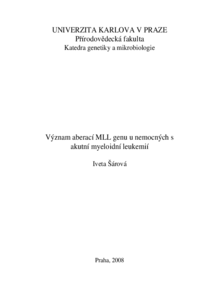Význam aberací MLL genu u nemocných s akutní myeloidní leukemií
Significance of MLL gene aberrations in patients with acute myeloid leukemia
rigorózní práce (UZNÁNO)

Zobrazit/
Trvalý odkaz
http://hdl.handle.net/20.500.11956/31664Identifikátory
SIS: 99834
Katalog UK: 990012896500106986
Kolekce
- Kvalifikační práce [21474]
Autor
Fakulta / součást
Přírodovědecká fakulta
Obor
Genetika, molekulární biologie a virologie
Katedra / ústav / klinika
Katedra genetiky a mikrobiologie
Datum obhajoby
9. 12. 2010
Nakladatel
Univerzita Karlova, Přírodovědecká fakultaJazyk
Čeština
Známka
Uznáno
Klíčová slova (česky)
akutní myeloidní leukemie, MLL, translokace, amplifikace, komplexní přestavby karyotypu, FISH, TELKlíčová slova (anglicky)
acute myeloid leukemia, MLL, translocation, amplification, complex rearrangement of the karyotype, FISH, TELAberace chromozomu 11 postihují u akutní myeloidní leukemie (AML), konkrétně u subtypu AML-M5, nejčastěji oblast 11q23. Pomocí molekulárních studií translokací 11q23.3 byl identifikován gen MLL (myeloid/lymphoid leukemia) účastnící se těchto přestaveb. Gen MLL kóduje transkripční faktor regulující expresi specifických HOX (homeobox) genů a je důležitý pro normální průběh ontogeneze a vývoj krevních buněk. Chromozomové aberace MLL genu se vyskytují u 5 - 10 % nemocných s AML a jsou velmi variabilní. Do roku 2008 bylo popsáno více než 70 různých translokací tohoto genu. Alterace MLL genu bývají často spojovány s agresivním typem onemocnění a tedy i špatnou prognózou pro nemocného. Jejich detekce je proto nezbytná pro volbu léčebné terapie. V této práci uvádím analýzu abnormalit MLL genu detekovaných v buňkách kostní dřeně u 66 nemocných s nově diagnostikovanou AML pomocí metod klasické cytogenetiky a fluorescenční in situ hybridizace (FISH) s komerčně dodávanou sondou pro MLL gen (Abbott VYSIS). Aberace MLL genu byla prokázána u 9 (13,6%) nemocných: 5x translokace (7,6%), 3x mnohonásobná amplifikace (4,5%) a 1x duplikace MLL genu (1,5%). Výsledky FISH analýzy byly upřesněny metodami mnohobarevné FISH (mFISH) a mnohobarevného pruhování (mBAND). V této studii také uvádím nový možný partnerský gen - gen...
In acute myeloid leukemia (AML), predominantly in AML M5a, the most frequent recurrent aberration of chromosome 11 involves region 11q23. Molecular breakpoint studies of several translocations involving chromosomal band 11q23 led to the detection of a gene that was named MLL (myeloid/lymphoid leukemia). This gene is important for the proper HOX gene expression during ontogenesis and hematopoiesis. Chromosomal aberrations affecting the MLL gene occur in 5 - 10 % of AML cases and are very variable. Since that time, more than 70 different translocation partners of the MLL gene have been described. Aberrations of the MLL gene are associated with an aggresive type of the disease and its detection is needed for the treatment decision. Therefore, we investigated the occurrence of MLL abnormalities in bone marrow cells of the 66 newly diagnosed AML patients, using conventional cytogenetic and fluorescence in situ hybridization (FISH) analyses with a commercially available MLL Break Apart Rearrangement probe (Abbott VYSIS). Out of the 66 patients, we proved MLL abnormalities in 9 (13,6%): 5 (7,6%) showed translocation of MLL gene, in 3 (4,5%) we detected MLL gene amplification without any evidence of rearrangement and in 1 (1,5%) pacient only an extra copy of the MLL gene. The FISH results were verified by...
